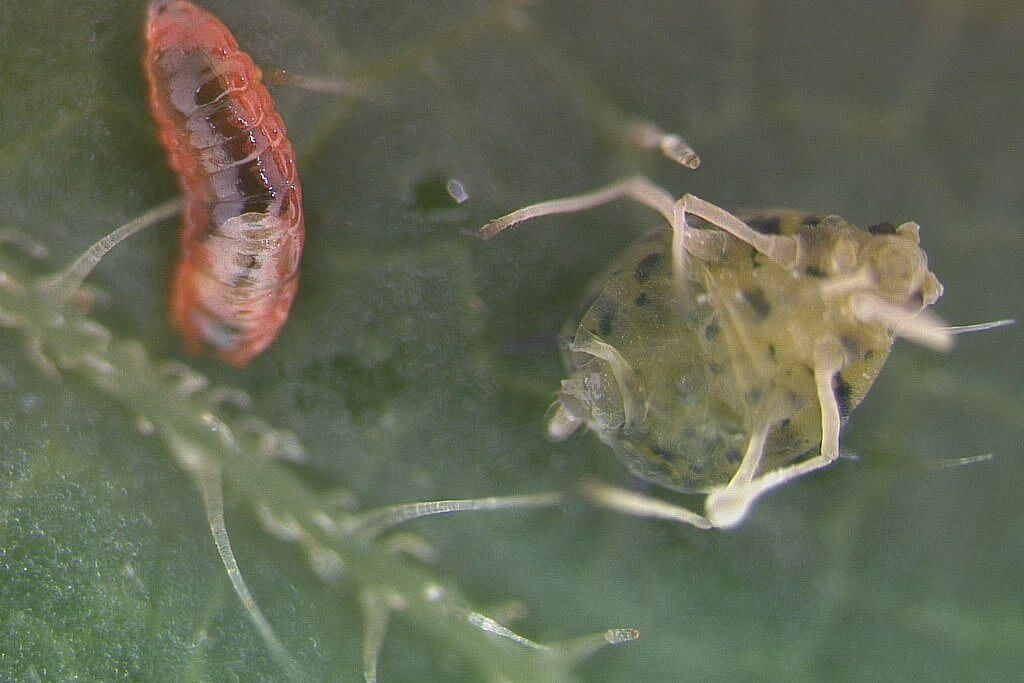A parasitic larva abandons its host and flees when in mortal danger

By: Noam Levithan and Yonat Ashchar
The life of the banana leaf aphid (Pentalonia nigronervosa) are not easy. As its name suggests, the aphid is a parasite of banana plants and since it is harmful, farmers try to exterminate it. Natural enemies of the aphid prey on it, in the worst case for it, or use it as a habitat for their offspring while it is alive in the worst case. Those offspring, which grow as parasites inside the aphid, receive a constant supply of food while feeding on its tissues as well as in an environment that hides them from their enemies. But they too may be harmed and even die when the surrogate aphid is in danger and attacked by a predator.
Many animals change their location to face danger and improve their chances of survival. For example, a person who chooses to enter a heated room when a blizzard is raging outside or birds migrating to warm countries rich in food. A change of location that can miraculously prolong the animal's life is escaping from a predator. However, a parasite that lives inside a host is trapped in its body, and therefore cannot escape in times of danger.
In an article published in the journal Proceedings of the Royal Society B, Frédéric Muratori, then from the Université catholique de Louvain in Belgium, and his colleagues describe for the first time how a larva of a fly (Cecidomyiidae) from the order of flies escapes from the banana aphid when attacked by a predator, a feature that gave the fly species its name: Endaphis fugitiva ("My face-aphid escaped"). This fly is a parasitoid ("parasite-like") of the aphid. Unlike true parasites, adult parasitoids are free-living. Their young stages develop at the expense of the host, often within its body, and result in its death when they are ready to leave. Since I'm a caterpillar E. fugitiva Needing aphids to develop inside their bodies, their mothers lay their eggs on leaves near groups of aphids. When the eggs hatch, the young larvae begin to hunt for aphids. When a caterpillar finds an empty aphid, meaning without another caterpillar inside, it climbs onto its stomach, pierces its exoskeleton and enters its body between the thigh and chest. The larva feeds on the tissues of the aphid until it reaches adulthood. At this point he exits her body through her anus and jumps until he falls to the ground, spins a cocoon and incarnates. The aphid dies a few seconds after the larva emerges from its vicinity.
When a banana aphid used as a surrogate for the caterpillar was injured by the researchers, or was attacked by a predator, such as an aphid from the Arnimalai series, the larva waited a little before doing an act never seen in other parasitoids - it abandoned the aphid's body and fled to avoid predation. Muratori and his colleagues observed that larvae that were forced to abandon their aphid early were smaller (like prematures), and also remained as pupae longer than larvae that emerged from it at the right time. In the case of the Kneimari, the predation process lasted about 13 minutes and the larva escaped within three and a half minutes.
The researchers hypothesize that the larva does not escape the aphid immediately when it is attacked since the pupa is vulnerable to dangers and early abandonment extends the time spent as a pupa. The larva assesses the danger posed to the aphid, apparently by sensing the pressure exerted by the predator on the aphid's body or by chemical factors secreted during stress into the hemolymph ("blood") of the aphid. If it seems that there is a high chance that the aphid will be eaten, and therefore the decision to stay inside it will result in its death, the larva will choose to abandon the aphid early and risk a longer incarnation period.
Muratori and his colleagues' research revealed the first case of an escaped parasitoid, E. fugitiva, capable of abandoning its host in case of mortal danger. In their opinion, it is possible that this feature has also evolved in other parasitoids, especially those that grow inside hosts subject to a high risk of predation. This trick allows them to continue living even if their host dies sooner than expected.
This entry is the first in the "Enemy Within" series of articles, centered on parasites and their surrogates. The next record The series deals with fungi, asexual reproduction in rotifers and the evolution of sex.
The original article was published inBlog of Dr. Noam Levitan SciPhile and in the Galileo magazine
The original article:
Muratori, FB, Borlee, S. & Messing, RH Induced niche shift as an anti-predator response for an endoparasitoid. Proc. R. Soc. B 277, 1475-1480 (2010). doi: 10.1098/rspb.2009.2029

One response
Literally "the 8th passenger". Just fear. Lives in it and eats it and then comes out while killing it